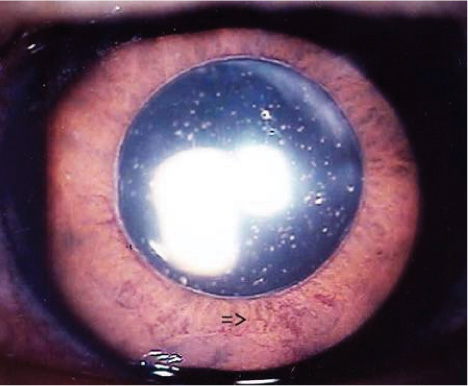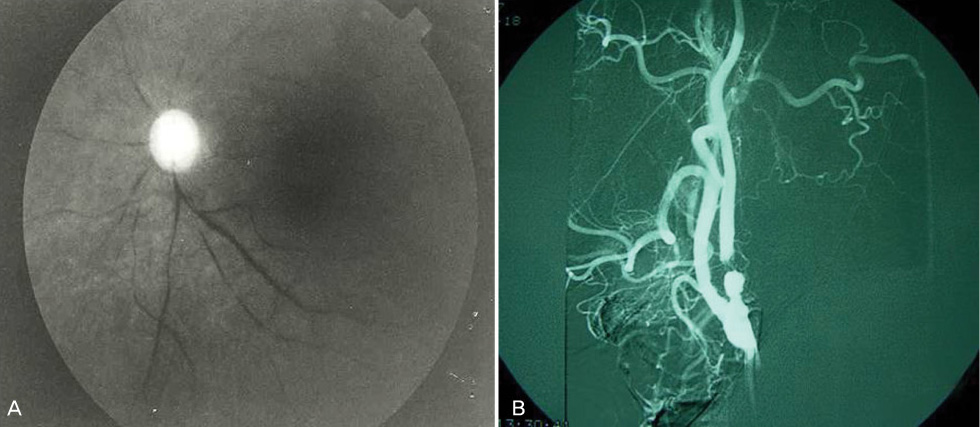Korean J Ophthalmol.
2009 Jun;23(2):132-134. 10.3341/kjo.2009.23.2.132.
Intravitreal Bevacizumab (Avastin) Treatment of Neovascular Glaucoma in Ocular Ischemic Syndrome
- Affiliations
-
- 1Department of Ophthalmology, College of Medcine, Kosin University, Busan, Korea. shdkim@ns.kosinmed.or.kr
- 2Institute for Medicine, College of Medcine, Kosin University, Busan, Korea.
- KMID: 754734
- DOI: http://doi.org/10.3341/kjo.2009.23.2.132
Abstract
- We report a case of ocular ischemic syndrome accompanied by neovascular glaucoma that was successfully treated with Bevacizumab. A 70-year-old male patient diagnosed with neovascular glaucoma of the left eye 3-4 years prior complained of continuous left eye pain and declining visual acuity despite receiving the latest treatment methods. At the time of admission the patient had no light perception in the left eye and his intraocular pressure was 30 mmHg. Anterior segment and fundus examinations revealed neovascularization of the iris and stenosis of the retinal vessel. Hypofluorescence of the choroid and retinal vessels was observed on fluorescence fundus angiography. Left internal carotid artery stenosis was observed on a brain MRI. Despite being treated with eye solution and oral medication, intraocular pressure was not controlled. After 7 days, we performed an intravitreal Bevacizumab 1.25 mg/0.05mL injection. One day after the intravitreal Bevacizumab injection, the neovascularization had nearly regressed and intraocular pressure was 30 mmHg. Intravitreal Bevacizumab injection produced regression of neovascularization and proved effective for treatment of neovascular glaucoma in this case of ocular ischemic syndrome.
Keyword
MeSH Terms
-
Aged
Angiogenesis Inhibitors/*administration & dosage
Antibodies, Monoclonal/*administration & dosage
Carotid Stenosis/*complications/diagnosis
Diagnosis, Differential
Eye/*blood supply
Fluorescein Angiography
Fundus Oculi
Glaucoma, Neovascular/diagnosis/*drug therapy/etiology
Humans
Injections
Ischemia/*complications/diagnosis
Magnetic Resonance Angiography
Male
Vascular Endothelial Growth Factor A
Vitreous Body
Figure
Reference
-
1. Michels S, Rosenfeld PJ, Puliafito CA, et al. Systemic bevacizumab (Avastin) therapy for neovascular age-related macular degeneration: twelve-week result of an uncontrolled open-label clinical study. Ophthalmology. 2005. 112:1035–1047.2. Reichel E. Intravitreal bevacizumab for choroidal neovascularization and cystoid macular edema: a cost-effective treatment. Ophthalmic Surg Laser Imaging. 2005. 36:270–271.3. Ferrata N. Vascular endothelial growth factor: basic science and clinical progress. Endocr Rev. 2004. 25:581–611.4. Howitz H, Fehrenbacher L, Novotny W, et al. Bevacizumab plus irnotecan, fluorouracil, and leucovorin for metastatic colorectal cancer. N Engl J Med. 2004. 350:2335–2342.5. Rosenfeld PJ, Mosfeghi AA, Puliafito CA. Optical coherence tomography finding after an intravitreal injection of bevacizumab (Avastin) for neovascular age-related macular degeneration. Ophthalmic Surg Laser Imaging. 2005. 36:331–335.6. Kahook MY, Schuman JS, Noecker RJ. intravitreal bevacizumab in a patient with neovascular glaucoma. Ophthalmic Surg Laser Imaging. 2006. 37:144–146.
- Full Text Links
- Actions
-
Cited
- CITED
-
- Close
- Share
- Similar articles
-
- Intraviteal Bevacizumab (Avastin(R)) Injection for the Treatment of Early-Stage Neovascular Glaucoma
- A Case of Ocular Ischemic Syndrome Associated with Multiple Branch Retinal Artery Occlusion and Neovascular Glaucoma
- Clinical Course after Intravitreal Bevacizumab Injection in Ischemic Central Retinal Vein Obstruction
- A Case of Neovascular Glaucoma Secondary to Ocular Ischemic Syndrome in a Patient with Moyamoya Disease
- Acute Visual Loss after Intravitreal Bevacizumab Injection in a Patient with Ocular Ischemic Syndrome




